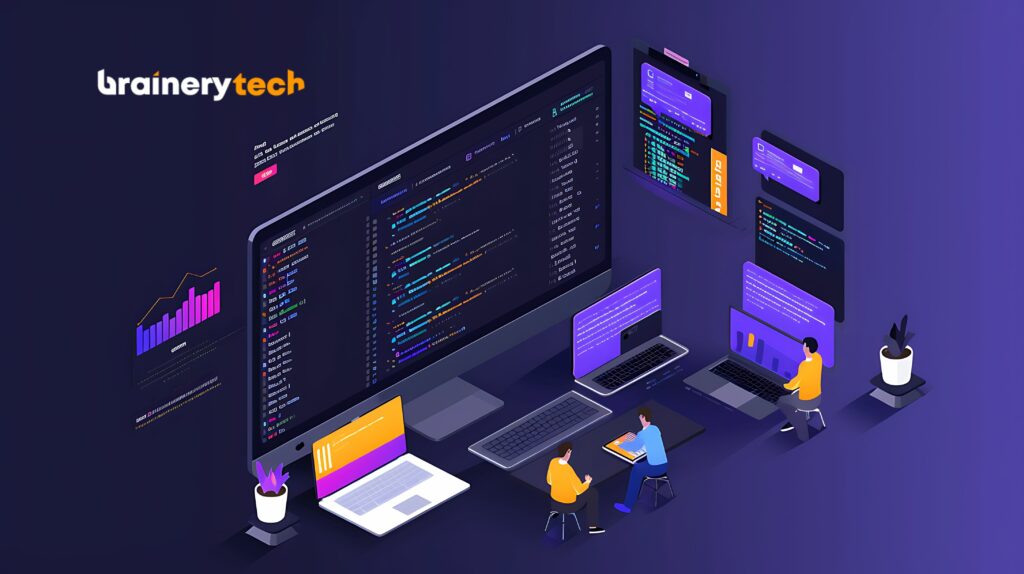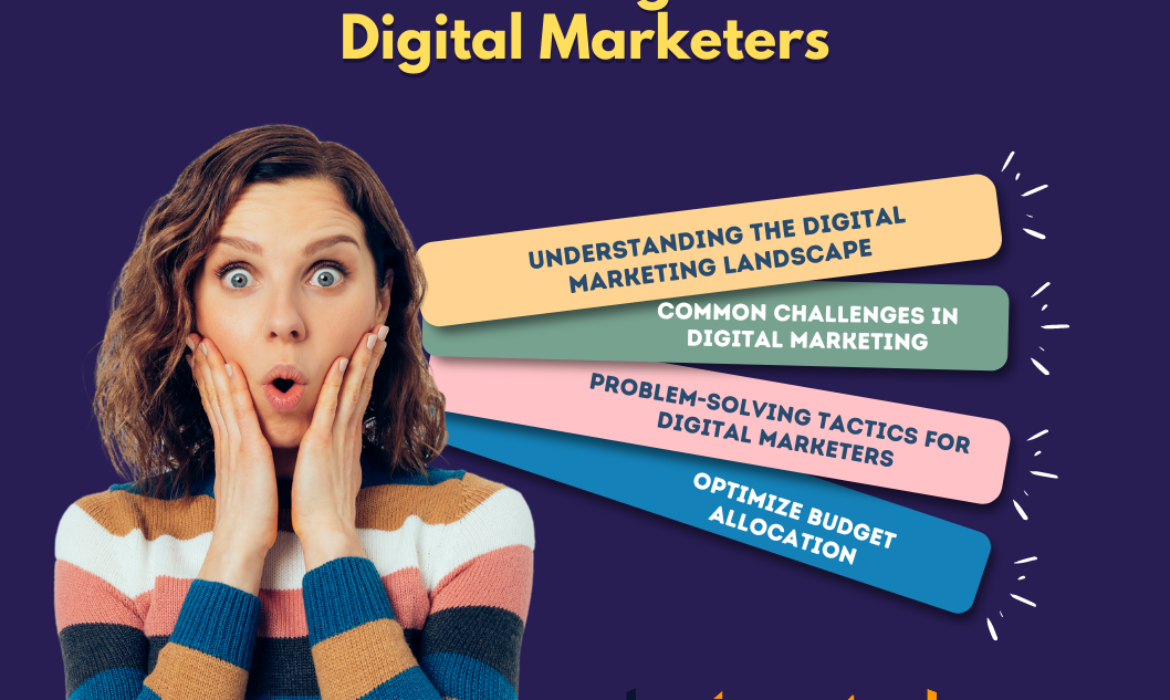Problem-Solving Tactics for Digital Marketers
The dynamic world of digital marketing, challenges are inevitable. From staying ahead of algorithm changes to navigating the complexities of consumer behavior, marketers face a myriad of barriers in their quest for success.
However, these challenges also present opportunities to innovate, strategize, and push the boundaries of what’s possible.
Today i’ll shre some problem-solving tactics that digital marketers can leverage to break through these barriers, optimize their campaigns, and ultimately achieve their goals.
Today i’ll share some problem-solving tactics that digital marketers can leverage to break through these barriers, optimize their campaigns, and ultimately achieve their goals.
Understanding the Digital Marketing Landscape
Before diving into specific tactics, it’s essential to understand the landscape in which digital marketers operate. The digital marketing environment is ever-evolving, influenced by factors such as technological advancements, consumer behavior shifts, and economic changes. Staying updated with these trends is crucial for effective problem-solving.
- Technology: Rapid technological advancements, from AI and machine learning to automation tools, have reshaped how digital marketers operate. Understanding and leveraging these technologies can help marketers tackle challenges more effectively.
- Consumer Behavior: The modern consumer is more informed and selective than ever. Digital marketers must adapt to these changes by focusing on personalization, engagement, and creating value-driven content.
- Economic Factors: Economic shifts can impact marketing budgets and consumer spending habits. Marketers need to be agile, adapting their strategies to the current economic climate.


Common Challenges in Digital Marketing
Digital marketing comes with its own set of challenges that can hinder progress if not addressed promptly. Here are some of the most common obstacles:
- Algorithm Changes: Search engines and social media platforms frequently update their algorithms, affecting visibility and engagement rates.
- Data Privacy Regulations: With regulations like GDPR and CCPA, marketers must navigate the complexities of data privacy while maintaining personalized marketing efforts.
- Content Saturation: The internet is flooded with content, making it harder for brands to stand out and capture the attention of their target audience.
- Budget Constraints: Limited budgets can restrict the scope of campaigns, especially for small businesses or startups.
- Measuring ROI: Accurately measuring the return on investment (ROI) for digital marketing efforts can be challenging, particularly with multi-channel campaigns.

Problem-Solving Tactics for Digital Marketers
Now that we’ve outlined the common challenges, let’s explore actionable tactics that digital marketers can employ to overcome these barriers.
- Embrace Data-Driven Decision-Making
Data is the backbone of modern digital marketing. By leveraging data, marketers can make informed decisions, optimize campaigns, and anticipate challenges before they arise.
- or SEMrush to collect data on consumer behavior, campaign performance, and website traffic. Analyze this data to identify patterns and trends that can inform your marketing strategy.
- A/B Testing: A/B testing allows you to experiment with different variations of your content, ads, or landing pages to see which performs better. This data-driven approach can help you refine your campaigns for maximum impact.
Predictive Analytics: Utilize predictive analytics to forecast future trends and behaviors. This can help you stay ahead of the curve and proactively adjust your marketing strategy.
2. Adapt to Algorithm Changes
Algorithm changes can significantly impact your online visibility, especially in search engines and social media platforms. Staying informed and adapting to these changes is crucial.
- Stay Updated: Follow industry news, blogs, and forums to stay informed about upcoming algorithm changes. Websites like Search Engine Journal, Moz, and Social Media Examiner are excellent resources.
- Diversify Your Strategy: Relying on a single platform for traffic or leads is risky. Diversify your digital marketing efforts across multiple channels—SEO, social media, email marketing, and paid advertising—to mitigate the impact of algorithm changes.
- Focus on Quality Content: Regardless of algorithm updates, high-quality, relevant content remains a constant. Create content that provides value to your audience, and optimize it for both users and search engines.
3. Navigate Data Privacy Regulations
- Understand the Regulations: Familiarize yourself with data privacy laws like GDPR, CCPA, and any regional regulations that apply to your business. This will help you avoid legal pitfalls and maintain consumer trust.
- Transparency with Consumers: Be transparent about how you collect, store, and use consumer data. Provide clear opt-in and opt-out options and ensure that your privacy policy is easily accessible.
- Leverage First-Party Data: With third-party cookies on the decline, focus on collecting first-party data directly from your customers. This data is more reliable and less susceptible to regulatory changes.
4. Stand Out in a Saturated Market
With so much content vying for attention, standing out in a saturated market requires creativity and strategic thinking. Identify Your Unique Selling Proposition (USP): What makes your brand or product different from the competition? Highlight your USP in your marketing efforts to capture your audience’s attention
- Focus on Storytelling: People connect with stories, not just products or services. Use storytelling in your content marketing to engage your audience on an emotional level.
- Interactive Content: Incorporate interactive content like quizzes, polls, and interactive infographics to engage your audience. Interactive content is more likely to be shared, increasing your reach.
- Video Marketing: Video content continues to dominate. Use videos to showcase your brand, demonstrate products, or provide tutorials. Platforms like YouTube, Instagram, and TikTok are ideal for video marketing.
Optimize Budget Allocation
Budget constraints are a common challenge, but you can maximize your marketing dollars with careful planning.
- Prioritize High-ROI Channels: Analyze past performance to identify which channels yield the highest ROI. Allocate more of your budget to these channels while scaling back on underperforming ones.
- Utilize Low-Cost Marketing Tactics: Content marketing, social media, and email marketing can be cost-effective ways to reach your audience. Focus on creating valuable content and building relationships with your audience.
- Negotiate with Vendors: If you’re working with external vendors for services like PPC management or content creation, don’t hesitate to negotiate rates. Long-term partnerships often come with discounts or flexible payment terms.
6. Measure and Optimize ROI
Accurately measuring ROI is critical for understanding the effectiveness of your marketing efforts and making data-driven adjustments. Set Clear Goals: Define specific, measurable goals for each campaign. Whether it’s increasing website traffic, generating leads, or boosting sales, having clear objectives will help you track ROI more effectively.
- Use Attribution Models: Attribution models help you understand which channels and touchpoints contribute to conversions. This insight can inform your budget allocation and optimization efforts.
- Continuous Optimization: Digital marketing is not a “set it and forget it” endeavor. Continuously monitor campaign performance and make adjustments as needed. Regularly testing and refining your approach will lead to better results over time.
Conclusion
Digital marketing is a complex, fast-paced field that requires constant adaptation and problem-solving. By understanding your challenges and implementing the tactics outlined in this blog, you can break through barriers, optimize your campaigns, and achieve your marketing goals.
Remember, the key to successful digital marketing lies in staying informed, being agile, and always putting the needs of your audience first. As you navigate the ever-changing digital landscape, keep these principles in mind, and you’ll be well-equipped to overcome any obstacle that comes your way.
Website Development 2024: The Ultimate Guide to Thriving
As we step into 2024, website development is at the forefront of digital innovation, pushing the boundaries of what’s possible online. Developers are challenged to create websites that are not only visually appealing but also functional, secure, and optimized for both users and search engines.
This comprehensive guide delves into the key trends, tools, and strategies essential for thriving in the competitive landscape of website development in 2024
1. Embracing the Latest Design Trend
Web design continues to evolve, with 2024 shifting towards user-centric and modern aesthetics that prioritize engagement and functionality. The most notable design trends include:
Dark Mode: This design choice is favored for its sleek, modern appearance and energy efficiency, offering a comfortable viewing experience, especially in low-light environments.
Neomorphism: Combining the depth of skeuomorphism with the simplicity of flat design, neomorphism creates a soft, extruded visual style that mimics real-world objects, providing a unique and tactile experience.
Micro–Animations: These subtle animations enhance interactivity and engagement without overwhelming users, making websites feel more dynamic and responsive.
Asymmetrical Layouts: Moving away from traditional grid patterns, asymmetrical designs offer a fresh, visually intriguing approach that captures attention and differentiates websites.


2. Prioritizing Mobile-First Design
With mobile devices dominating global web traffic, adopting a mobile-first approach is crucial in 2024. Key strategies to ensure optimal mobile experiences include:
Responsive Frameworks: Utilize frameworks like Bootstrap or Foundation to create websites that seamlessly adapt to various screen sizes, ensuring a consistent and enjoyable user experience.
Touch–Friendly Design: Optimize interactive elements such as buttons and forms for touch interfaces, making navigation smoother and more intuitive on mobile devices.
Mobile–Optimized Content: Streamline content for mobile consumption, ensuring images and videos are properly scaled and concise text to enhance load times and user experience.
3. Leveraging AI and Machine Learning
AI and machine learning are transforming the way websites are developed and interacted with, offering new possibilities for personalization, automation, and engagement. Key applications include:
Personalization: AI analyzes user behavior to deliver tailored content, creating a more relevant and engaging experience.
AI–Powered Search Engines: These engines better understand user intent, providing more accurate and useful search results.
Chatbots and Virtual Assistants: AI-driven chatbots offer real-time support, improving customer satisfaction and interaction through instant, 24/7 service.
4. Enhancing Performance and Speed
Website performance remains a critical factor for both user experience and SEO. In 2024, developers must focus on optimizing site speed and performance through strategies such as:
Minimizing HTTP Requests: Reduce the number of elements on a page to decrease load times and improve overall site performance.
Optimizing Images and Media: Use modern formats like WebP and compress images to reduce file sizes without sacrificing quality.
Utilizing Content Delivery Networks (CDNs): CDNs distribute content across multiple servers globally, ensuring faster load times for users regardless of their location.

5. Strengthening Security Measures
Cybersecurity is more important than ever, with the need to protect user data and maintain trust being paramount in 2024. Essential security practices include:
SSL Certificates: Ensure all websites are HTTPS-secured with SSL certificates to protect data transmission and build user trust.
Regular Updates: Keep CMS, plugins, and other software up to date to prevent vulnerabilities and maintain a secure environment.
Advanced Authentication: Implement multi-factor authentication (MFA) and encourage the use of strong, unique passwords to enhance security.
6. Focusing on User Experience (UX
A superior user experience (UX) is essential for retaining visitors and converting them into customers. Key practices to enhance UX include:
Intuitive Navigation: Design easy-to-use navigation menus and site structures that guide users smoothly through content.
Fast Load Times: Ensure your site loads quickly across all devices to prevent user frustration and reduce bounce rates.
Accessible Design: Make your website accessible to all users, including those with disabilities, by adhering to WCAG guidelines.
7. Exploring Progressive Web Apps (PWAs)
Progressive Web Apps (PWAs) offer a fast, reliable, and app-like experience by combining the best features of web and mobile applications. The key benefits of PWAs include:
Push Notifications: Engage users with timely updates and information directly through their devices.
Offline Access: Allow users to access content without an internet connection, improving usability and reliability.
App–Like Experience: PWAs provide features like home screen icons and full-screen modes, offering an immersive user experience.
8. Optimizing for Voice Search
The rise of smart speakers and voice assistants makes optimizing websites for voice search increasingly important. Key strategies include:
Conversational Keywords: Use natural language and long-tail keywords that reflect how people speak, improving the chances of appearing in voice search results.
Featured Snippets: Structure content to appear in featured snippets, as these are often used in voice search responses.
Local SEO: Focus on optimizing for local search queries to capture voice searches related to nearby services and businesses.
Conclusion
In 2024, thriving in website development requires staying at the cutting edge of technology and design. By embracing modern trends, prioritizing user experience, leveraging AI and emerging technologies, and adopting sustainable practices, developers can create websites that not only meet but exceed user expectations. Stay adaptable, continuously learn, and implement these strategies to ensure your website remains competitive and successful in the ever-evolving digital landscape.





